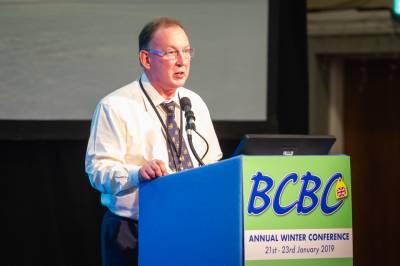
Who we are
With my wife Sarah, daughter Laura and son Ben, I own and manage Tomschoice Limousins, perched on the side of the beautiful and picturesque Nidderdale Valley between Harrogate and Skipton in North Yorkshire.
I felt very proud to be asked to talk today; we are not big farmers, we have not had huge prices for bulls or cows and we are not regularly winning at big shows. We don’t breed show heifers, show cows or produce bulls to produce show calves. So why have they asked me to come to talk today?
I would like to talk to you about building a brand to promote uniqueness and how we have tried to produce bulls for commercial farmers and for use on heifers.
To date we have sold 7 bulls to studs in the UK and Ireland, the 8th is currently in the process of negotiation. This is unusual for a single pedigree herd, it hasn’t happened by chance and is the basis of this presentation. How have we managed to do this and why? (see Figure 1).
Figure 1
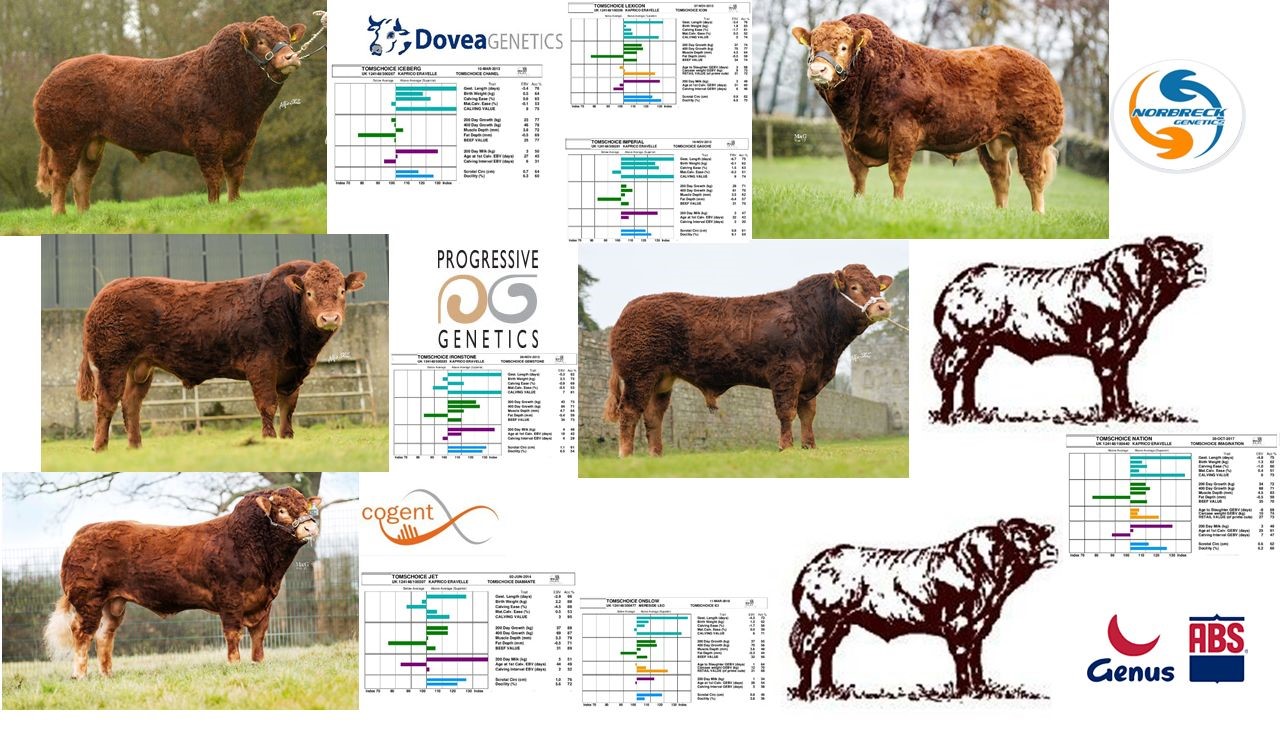
I am by birth a Lincolnshire boy where my Father was a tenant farmer. I was brought up in a crumbling house with crumbling farm buildings until Lord Carrington bought the Estate in the 70’s and modernised it.
Unable to gain the farm tenancy I became a Trainee Manager in my future father-in-laws food company in Ripon.
After marrying, Sarah and I bought a small cottage locally to Ripon, did it up and then sold it, in return we bought a crumbling house with crumbling buildings (I have returned to my childhood again!) and 40 acres of not very good grass. We have then invested time and money, blood sweat and tears over the last 30 years. We now farm 130 acres of ring-fenced grass that we have dramatically improved. We also have a sign on the gate that says we are a wholly owned subsidiary of the HSBC group!
How we started
The first cattle we purchased were Limousin cross and Hereford cross Friesians and we gradually built up to circa 20 cows, progeny would sell at Skipton store sale just before Christmas where we usually did well. I soon realised however that producing 20 animals a year was not going to pay many bills.
Therefore, we decided to look at going pedigree where we thought there would be more income. Naively I assumed that you won at a few shows and everyone would come flocking to buy your animals! Hah! Our first pedigree purchase was Stoneleigh Ginger at Leyburn in 1996 with heifer calf at foot and in calf again. My friend Tom picked her out, she was Tom’s choice! Since then we have sold the wrong ones and kept the wrong ones, and are still doing it today, but in a more informed way!
We have steadily increased numbers to 53 cows calving this year with the aim to get to around 60.
Where we were
We started going to a few shows and for the first 3 years consistently stood at the wrong end of the line, the only time we managed better than last was when we had two in the same class! But we were learning, when you are at the bottom of the heap the learning curve is steep and swift.
We started to take a few bulls to Carlisle but didn’t manage to sell anything of note until we had some success in 2000 with a bull at 4200gns. A few show winners, breed and interbreed champions came along in the next few years but we still were struggling selling. Why?
I started to look at what we were breeding more closely, were our bulls not good enough?
Frankly, some weren’t, but a good few were, we weren’t getting potential buyers to the pen before a sale, why not? We were producing good strong bulls with plenty of cover but they were lost in the market with hundreds of other bulls. Or, we were getting the occasional buyer to the farm, but weren’t completing the sale. Were we too expensive? Was it me being a poor salesman or were the bulls not right?
By 2009 we were trying to chase the perfect bull, the £100k bull. We were producing show winning bulls that no one wanted to breed from! Bulls with bad calving figures that had plenty of condition.
The nearest we got was one at £13k and another at £10k in the October but most had gone to kill, bad legs or just not saleable.
The need for a plan
We needed to make changes.
We started to listen to and think about what potential customers asked for.
The first question when looking at a bull nearly always was, ‘will it calve?’ closely followed by the second, ‘will it kill me?’ then ‘will the calves grow?’ Another remark often made was ‘the bull has too much condition on, don’t want him’ and, ‘he’ll just melt away’.
The Limousin Society Bull Survey in 2011 also confirmed this with the top three comments being:
- Easy Calving
- Docility
- Over feeding of Sale Bulls
I had been to University (as a very mature student!) and achieved an MBA, a Master’s in Business and Administration or depending on your point of view, Master of B****r All. What had I learnt?
I had spent time learning about marketing, differentiation, unique selling points, customer satisfaction and making purchasing a delightful experience. It was time to try to apply some of what I had learnt.
The plan
We needed to have a unique selling point, something that would differentiate our product.
We came up with an idea of what we would like to do.
We wanted to produce:
1. Easily calved progeny with short gestation
We did not just want easy calving as we didn’t want to produce cattle with narrow hips and no growth, therefore thinking slightly laterally we decided upon trying to purchase a bull with ‘Short Gestation’, reasoning that if the calf was in the cow for a shorter period of time it would be smaller.
Research by Ferell & Orourke et al. 1991 showed that the increase of body weight of a calf from 6 to 9 months is about 3 times greater than the increase from 3 to 6 months and by 230 days growth is at circa 1/3 kg per day.
Having decided that we wanted to produce bulls with short gestation lengths we needed to find the sire.
We purchased Homebyres Drummie, at Carlisle May 2010, he was decent looking but most important he was in the top 1% of the breed for gestation length whilst still being in the top 25% of the breed for 400 day growth.
Then, as usually happens, a major setback, he proved to only be semifertile due to a twisted tube and whilst we got some cows in calf it was a realm struggle.
Back to find another bull we chanced upon Kaprico Eravelle. Top 1% for gestation, top 1% for 400 day growth. An outlier, a genetic curve bender and different breeding to anything we had. His locomotion was good, a decent head, a very big pair of testicles and he was as long as a train; he had a lovely temperament and was from a Johnes 1 accredited herd.
We had our first calves in December 2010, they all but fell out at around 282 days, they looked like little fawns. Oh my goodness, what had we bought? Thank goodness we had used some AI as well, the calves looked awful then suddenly at about 6–8 weeks old somebody had been in the shed overnight with a bicycle pump and had pumped them all up! Bingo!
From this point we have consistently out-performed the breed average for gestation length and it has become a major unique selling point for us (see Figure 2).
Figure 2
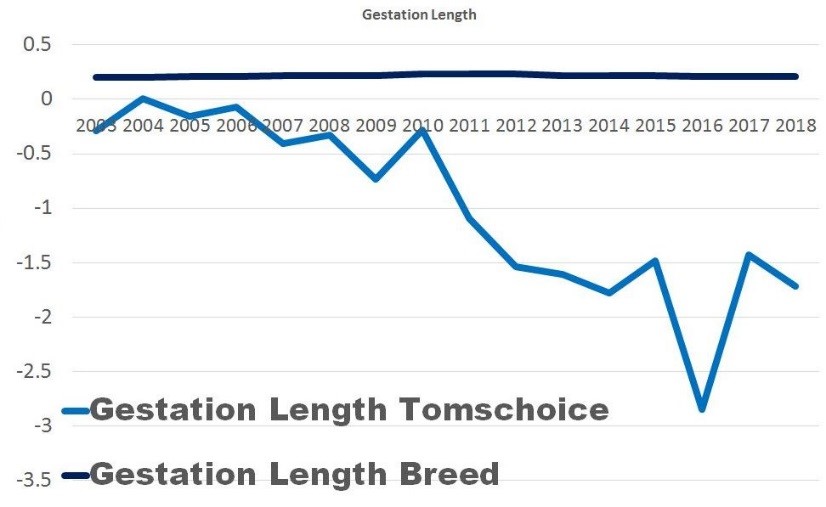
2. High docility
We started to halter train everything on farm as yearlings. Convenient for customers, but, really a method of selection; operating a three strikes and you’re out rule, that is three attempts at halter training and if you aren’t coming round and/or showing aggression you are down the road. We have lost one or two good looking animals following this policy but the herd is much better without them (see Figures 3 and 4).
Figure 3
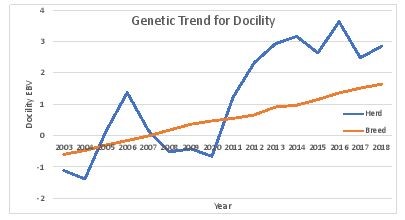
Figure 4
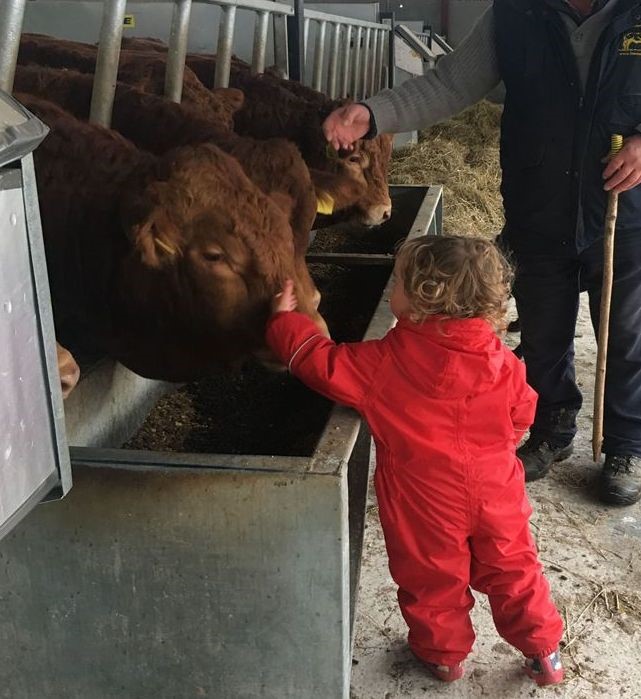
3. A Decent Looking Bull with Good Locomotion
Bulls still need to look the part and satisfy a good stockpersons eye. Potential customers often complained that bulls were too fat, over conditioned. As a consequence we decided to sacrifice a small paddock and started to turn bulls out pretty much every day starting a week or so after weaning.
We found that they were waiting at the door every morning wanting to go out. There were some day’s weather wise over winter when they were soon stood at the gate wanting to come in as well! We rarely get locomotion issues now, exercise keeps them fit.
4. Good growth rates
Weighing calves every 100 days we found that they were doing just as well with the additional exercise; the young bulls particularly had less fat cover and looked raw. What we are now seeing is that we are producing bulls with reduced 400 day weights as we rein in the feeding regime but at the same time the bulls are of higher genetic worth; that is their progeny will grow at a superior rate. The results from the DEFRA/AHDB Feed Efficiency trials will be interesting to see. Once incorporated in to the Limousin genetic evaluation it will hopefully help us in the future to see better what is happening and continue to provide genetics for traits that are commercially relevant to our customers and the wider supply chain.
5. Meat in the right places
Back fat scanning revealed that our animals were leaner and at the same time the muscle score was higher, a result of the breeding plus the exercise regime. The Limousin Society started research in 2011 as part of their Breed Improvement Plan to produce Carcase Trait GEBVs, with the first results published in 2016. As soon as we could we started to collect genotype data for our animals to see what type of carcase we were producing and what their genetic merit was. Whilst not a substitute for the eye of a good stockman it is another tool to use when selecting breeding animals.
Our first two sons from the new regime went to Carlisle in October 13, they looked very raw against the vast majority of other bulls at the sale but they sold well, averaging a little over 6000gns; very acceptable!
Unique selling points
Now that we were starting to produce a Unique Product we decided that we would also try to add value to the animal by offering if for sale with extras to try to get people to our pen pre-sale or onto farm.
1. Maintain High Health Status
We had joined the BCVA Health Scheme in 1999, this swapped into the SAC Scheme in 2002, and we achieved Johnes and BVD accreditation in 2004. Whilst one or two buyers would find this interesting it wasn’t until Limousin Society health declarations at sales started in 2007 that this really came to the fore. Then we started to get a few more buyers to the pen pre-sale and on farm. We were at the forefront with a known health status and have remained so to this date.
2. Semen test the bull prior to sale
Our vets had started to push us to semen test stock bulls annually, for a bulk quantity they would also semen test our young sale bulls at a better rate. Advertising the bulls as semen tested definitely brought more potential buyers to our pen pre-sale. We also started to semen test bulls sold from home as luck penny. Whilst realising that this does not guarantee a bull to work it gives us confidence in what we are selling and gives confidence to the buyer in the product he is purchasing.
3. DNA test for parentage, myostatin and GEBVs
Previously we had done some sire determination DNA testing, from 2011 we decided that it would be better to DNA everything at a week old when the animal was tagged. Job done.
The Limousin Society introduced Myostatin testing in 2011 and we decided to test at the same time as we parentage tested. The vast majority of the herd is carrying 2 copies of the F94L gene, bringing enhanced muscling with no impact on calving ease. As with the Myostatin testing we decided to have all calves analysed for the Carcase Trait GEBVs and to publish the data. We have found there to be a strong correlation between the visual appearance of a bull and his Carcase trait GEBV (Figure 5).
Figure 5
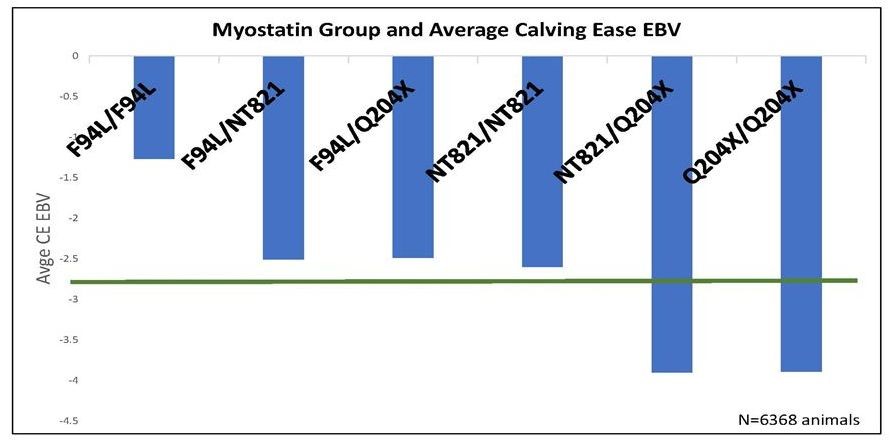
4. Guarantee the bull to work and stand behind him
We decided that buying a bull that didn’t work properly was like a car without an engine we would therefore promise that the bull would be guaranteed to work or your money back.
5. A policy of complete openness and honesty
If any bull has any minor defect, we find it better to tell the buyer rather than having them find it themselves.
We publish all data. GEBV data, coupled with the Myostatin testing, has allowed us to have a better insight into the potential breeding attributes of young bulls, to the point where, if we have someone coming to farm to buy a bull we can offer honest opinion on whether it is the bull for him or her! It is no longer just about looks.
The result
When we realised that we had a unique product we took 18000 straws of semen from Kaprico Eravelle and with Norbreck Genetics marketed him in the UK and Ireland, we sold all the straws in 18 months. As a consequence Bull studs became interested in his progeny and subsequently in other bulls from different sires that we are breeding (Figure 6).
Figure 6
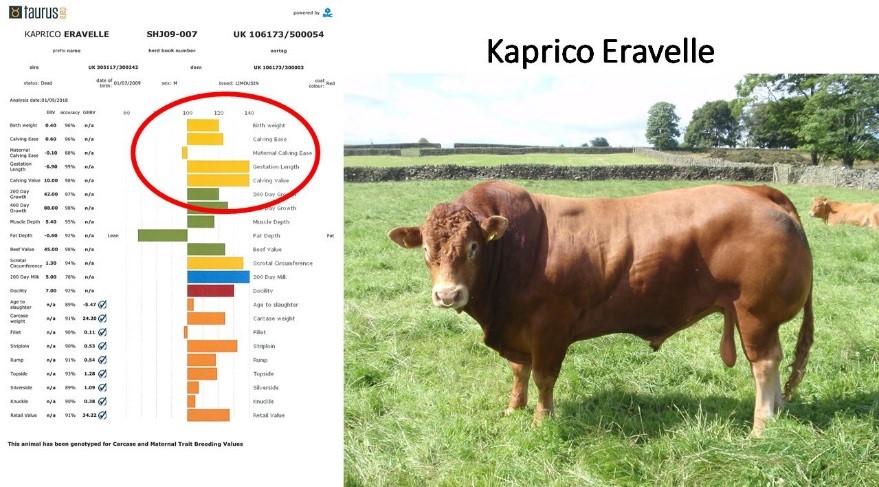
When we compare the profiles of all of the bulls that we have sold to stud, what do we see? Similarities?
- Short Gestation
- Better than average Growth Rates
- Large testicular development and high docility.
- The bulls sold more recently that have been tested also exhibit some high GEBV values for carcase traits. The Carcase trait GEBVs generated by the Limousin Society also demonstrate that a uniform carcase can be produced to meet a range of specifications for the retailer. High value cuts, with width, depth and length of loin.
It has taken us some time to find a like for like replacement for Eravelle.
We have high hopes for our latest addition to the herd, Goldies Nicholas (Figure 7).
Figure 7
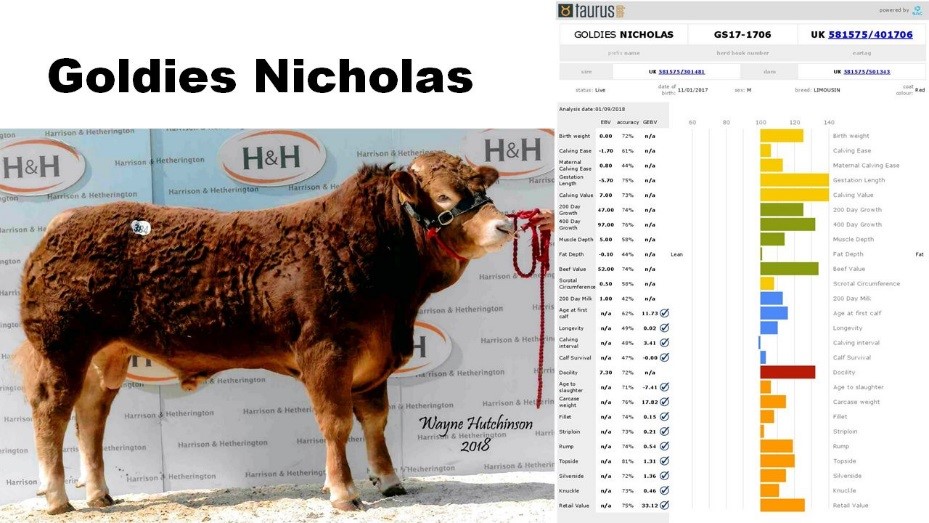
We hope that he will in turn be as successful for us going forward as Eravelle has done previously and we hope to be marketing semen from him towards the middle of next year.
Looking forward
What originally started off as an idea to try to create a unique product and selling point has now morphed; and it is the start, of what I believe is a survival strategy.
I can see a continued decline in the UK Suckler herd coupled with, or because, of increased use of sexed semen in the dairy industry, meaning that there will be more beef produced by an increasing number of spare dairy cows.
I believe it likely that we are going to see increasingly vocal vegetarian and vegan groups and increasing environmental pressure on beef production.
All at the same time as we are producing a product that is in terms of £/kg of protein is expensive compared to imported beef, chicken and pork.
All these pressures and an increase in the use of Beef AI in the dairy industry will most likely lead to a decline in the number of stock bulls required.
I would like to think that by breeding bulls with a short gestation that not only does it allow us to compete against other Limousin breeders but allows us to compete favourably against other breeds across the beef sector. We would like to be the herd of choice for studs to purchase their bulls from with a high health status and bulls that meet their requirements for looks, gestation, growth, docility and high genetic merit. There is little doubt that the Limousin produces a wonderful carcase that can be finished in a variety of ways to a variety of weights with excellent texture and taste to suit the retailer. Listening to market signals and deploying all new and emerging technology is key in achieving this. We value the continued underpinning investment by organisations such as the Limousin Society, AHDB & DEFRA in producing breeding tools. Our industry has a responsibility to demand it from them and become fully engaged in future long term development that will ensure we remain commercially relevant.
Continually having bulls working in stud propagates our Tomschoice brand to commercial producers and the dairy industry with the studs marketing our name for us. In turn this helps propagate our brand and helps to generate sales at home and at the Auction Markets.
The plan is that this will help usmflourish and continue to breed bulls in what I believe will be a difficult future environment.